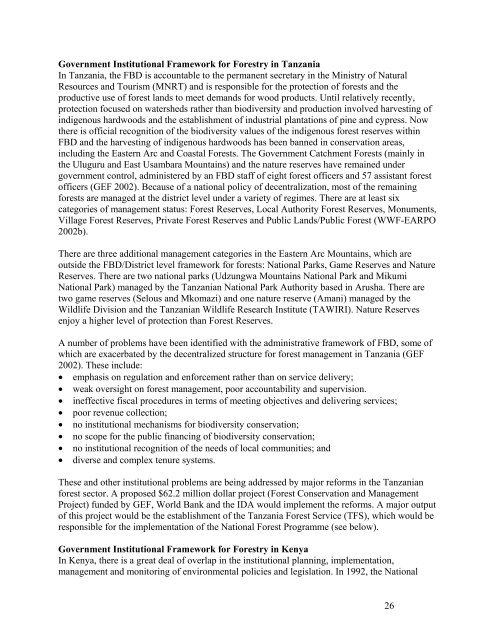Eastern Arc Mountains and Coastal Forests of Tanzania and Kenya ...
Eastern Arc Mountains and Coastal Forests of Tanzania and Kenya ...
Eastern Arc Mountains and Coastal Forests of Tanzania and Kenya ...
Create successful ePaper yourself
Turn your PDF publications into a flip-book with our unique Google optimized e-Paper software.
Government Institutional Framework for Forestry in <strong>Tanzania</strong>In <strong>Tanzania</strong>, the FBD is accountable to the permanent secretary in the Ministry <strong>of</strong> NaturalResources <strong>and</strong> Tourism (MNRT) <strong>and</strong> is responsible for the protection <strong>of</strong> forests <strong>and</strong> theproductive use <strong>of</strong> forest l<strong>and</strong>s to meet dem<strong>and</strong>s for wood products. Until relatively recently,protection focused on watersheds rather than biodiversity <strong>and</strong> production involved harvesting <strong>of</strong>indigenous hardwoods <strong>and</strong> the establishment <strong>of</strong> industrial plantations <strong>of</strong> pine <strong>and</strong> cypress. Nowthere is <strong>of</strong>ficial recognition <strong>of</strong> the biodiversity values <strong>of</strong> the indigenous forest reserves withinFBD <strong>and</strong> the harvesting <strong>of</strong> indigenous hardwoods has been banned in conservation areas,including the <strong>Eastern</strong> <strong>Arc</strong> <strong>and</strong> <strong>Coastal</strong> <strong>Forests</strong>. The Government Catchment <strong>Forests</strong> (mainly inthe Uluguru <strong>and</strong> East Usambara <strong>Mountains</strong>) <strong>and</strong> the nature reserves have remained undergovernment control, administered by an FBD staff <strong>of</strong> eight forest <strong>of</strong>ficers <strong>and</strong> 57 assistant forest<strong>of</strong>ficers (GEF 2002). Because <strong>of</strong> a national policy <strong>of</strong> decentralization, most <strong>of</strong> the remainingforests are managed at the district level under a variety <strong>of</strong> regimes. There are at least sixcategories <strong>of</strong> management status: Forest Reserves, Local Authority Forest Reserves, Monuments,Village Forest Reserves, Private Forest Reserves <strong>and</strong> Public L<strong>and</strong>s/Public Forest (WWF-EARPO2002b).There are three additional management categories in the <strong>Eastern</strong> <strong>Arc</strong> <strong>Mountains</strong>, which areoutside the FBD/District level framework for forests: National Parks, Game Reserves <strong>and</strong> NatureReserves. There are two national parks (Udzungwa <strong>Mountains</strong> National Park <strong>and</strong> MikumiNational Park) managed by the <strong>Tanzania</strong>n National Park Authority based in Arusha. There aretwo game reserves (Selous <strong>and</strong> Mkomazi) <strong>and</strong> one nature reserve (Amani) managed by theWildlife Division <strong>and</strong> the <strong>Tanzania</strong>n Wildlife Research Institute (TAWIRI). Nature Reservesenjoy a higher level <strong>of</strong> protection than Forest Reserves.A number <strong>of</strong> problems have been identified with the administrative framework <strong>of</strong> FBD, some <strong>of</strong>which are exacerbated by the decentralized structure for forest management in <strong>Tanzania</strong> (GEF2002). These include:• emphasis on regulation <strong>and</strong> enforcement rather than on service delivery;• weak oversight on forest management, poor accountability <strong>and</strong> supervision.• ineffective fiscal procedures in terms <strong>of</strong> meeting objectives <strong>and</strong> delivering services;• poor revenue collection;• no institutional mechanisms for biodiversity conservation;• no scope for the public financing <strong>of</strong> biodiversity conservation;• no institutional recognition <strong>of</strong> the needs <strong>of</strong> local communities; <strong>and</strong>• diverse <strong>and</strong> complex tenure systems.These <strong>and</strong> other institutional problems are being addressed by major reforms in the <strong>Tanzania</strong>nforest sector. A proposed $62.2 million dollar project (Forest Conservation <strong>and</strong> ManagementProject) funded by GEF, World Bank <strong>and</strong> the IDA would implement the reforms. A major output<strong>of</strong> this project would be the establishment <strong>of</strong> the <strong>Tanzania</strong> Forest Service (TFS), which would beresponsible for the implementation <strong>of</strong> the National Forest Programme (see below).Government Institutional Framework for Forestry in <strong>Kenya</strong>In <strong>Kenya</strong>, there is a great deal <strong>of</strong> overlap in the institutional planning, implementation,management <strong>and</strong> monitoring <strong>of</strong> environmental policies <strong>and</strong> legislation. In 1992, the National26
















